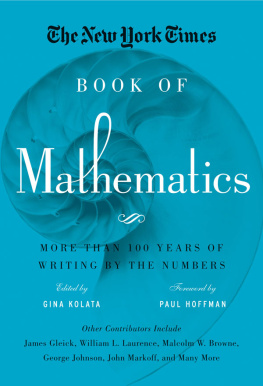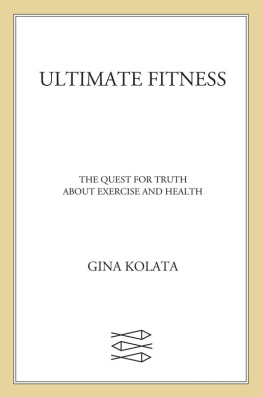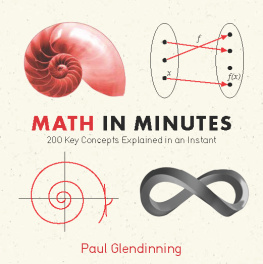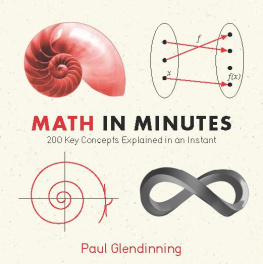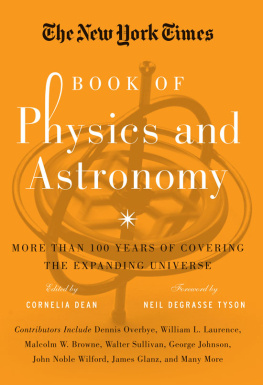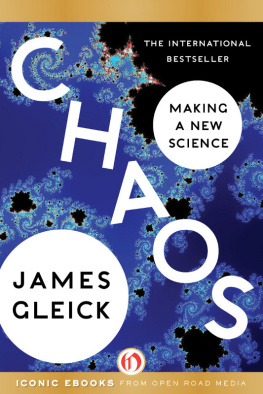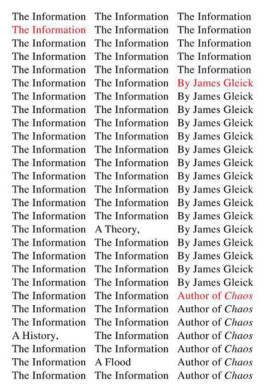The New York Times
BOOK OF
Mathematics

MORE THAN 100 YEARS OF
WRITING BY THE NUMBERS
| Edited by | Foreword by |
| GINA KOLATA | PAUL HOFFMAN |


An Imprint of Sterling Publishing
387 Park Avenue South
New York, NY 10016
STERLING and the distinctive Sterling logo are registered trademarks of Sterling Publishing Co., Inc.
2013 by The New York Times Company. All rights reserved.
All Material in this book was first published in The New York Times and is copyright The New York Times Company. All rights reserved.
The printing, copying, redistribution, or retransmission of the Material without express written permission is prohibited.
All rights reserved. No part of this publication may be reproduced, stored in a retrieval system, or transmitted, in any form or by any means, electronic, mechanical, photocopying, recording, or otherwise, without prior written permission from the publisher.
ISBN 978-1-4027-9328-8
For information about custom editions, special sales, and premium and corporate purchases, please contact Sterling Special Sales at 800-805-5489 or specialsales@sterlingpublishing.com.
2 4 6 8 10 9 7 5 3 1
www.sterlingpublishing.com
CONTENTS
A formidable student at Trinity
Solved the square root of infinity;
It gave him such fidgets
To count up the digits
He chucked math and took up divinity.
Anonymous
T his old limerick, penned by an anonymous wag, encapsulates two fundamental characteristics of mathematics and at least one misconception. The limerick correctly portrays mathematics as addressing big, head-spinning notions like that of infinity, and it gets across the fact that mathematical concepts can be difficult for laymen to comprehend. But the verse wrongly suggests that counting is the essence of mathematics. Counting is for bank tellers, cashiers, and CPAs. As the Times articles in this book make clear, mathematicians do much more than arithmetic. They are on the hunt for eternal universal truths, a quest that a budding theologian at Trinity would appreciate.
Around 300 B.C., Euclid of Alexandria offered a simple proof that there are infinitely many prime numbers (integers like 3, 5, 7, 11, and 13 that are divisible only by themselves and the number 1). His proof is as true today as it was twenty-three hundred years ago, and it will be true twenty-three hundred years from now. This kind of categorical certainty makes mathematics unique among the sciences. No matter how far out we go in the number line (beyond a hundred million, or a hundred million million, or a hundred million million million) there will always be primes. The truths of physics are not so universal. The discoveries of Newton and Einstein seem to hold only at certain familiar scales and not at far out distances.
More than the other sciences, mathematics seems to pose an abundance of simple questions that are beyond current human ingenuity. To take but one example in number theory, there is the unsolved puzzle of whether the supply of so-called twin primes (pairs of primes that differ by two, such as 3 and 5, 17 and 19, and 3,581 and 3,583) is inexhaustible. Although Euclid proved that the number of primes is infinite, generations of mathematicians have not been able to prove their suspicion that the number of twin primes is also infinite. Euclids proof is so simple that it can be written on one side of an index card. This raises the deep meta-mathematical question of why certain seemingly simple mathematical questions are maddeningly intractable compared to other related questions that readily give up their answers.
Contemporary mathematics is still about the search for eternal truths, but mathematicians now have a wider repertoire of techniques for getting at these truths. Chief among these is the computer, which itself is the product of mathematics, the binary language of 0s and 1s. I was in college in the mid 1970s when my professors at Harvard received word that two mathematicians in the Midwest had proved the century-old four-color conjecture, which asserts that any imaginary map of countries can always be colored with at most four colors in such a way that no two bordering countries share the same color. A lot of champagne was poured in the Harvard math department, but jubilation later gave way to consternation when word got out that the proof involved a computer doing much of the heavy lifting. It wasnt that my professors distrusted the proof; they presumed that the correctness of its numerous steps could be confirmed by running the proof on another machine. They were disquieted by the fact that the proof was so long that no human being would be able to assimilate it and understand why four colors were sufficient. For them a proof had to provide insight, and in this regard Euclids half-page proof was the gold standard: they could easily follow it and understand why the number of primes was infinite.
Youll learn from the Times articles within about the four-color conjecture and other intriguing mathematical conundrums that computers have helped to solve (for example, the party planners problem of determining the minimum number of guests that must be invited to guarantee that eight or more guests all know one another and that three or more will be strangers) and the meta issues such computer-aided proofs raise. Youll also find stories about famous problems such as Fermats Last Theorem and the Poincar conjecture that were recently proved the old-fashioned way, without depending on machines.
The men youll meet in these pages (and I say men, because few of these mathematicians are women) include other worldly eccentrics like Grigori Perelman, who solved the century-old Poincar conjecture only to retreat into the Russian woods, turning down both a $1-million reward and the Fields Medal, the equivalent in mathematics of the Nobel Prize, and Paul Erdos, arguably the worlds most prolific mathematician, a homeless Hungarian who, jacked up on amphetamines and espresso, worked on problems twenty hours a day and published more than 1,500 papers. Mathematicians are machines for turning coffee into theorems, Erdos would say. When colleagues asked him to slow down, hed reply, Theyll be plenty of time to rest in the grave. Erdos died at the age of eighty-three, but his mathematics, like all mathematics, is immortal. The discoveries he made, like Euclids and Grigoris, will hold up for eternity.
Paul Hoffman
CEO of Liberty Science Center and author of The Man Who Loved Only Numbers
A mathematician once dismissed the very idea that people outside his circle could ever understand the true essence of the field. Mathematics is an art form, like music or painting. Translating math into the English language, he said, is harder than translating Chinese poetry. The beauty is lost, the elegance, and a proof that is a thing of ineffable iridescence becomes reduced to a baffling or mundane-sounding bottom line.
Others echoed that sentiment. Fritz John, a mathematician at New York University, said he wanted neither fame nor fortune but merely the grudging admiration of a few close friends.

